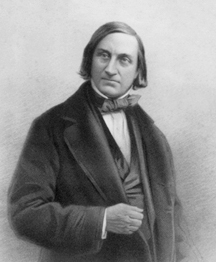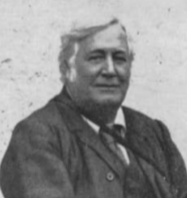
Charles Lapworth FRS FGS was a headteacher and an English geologist who pioneered faunal analysis using index fossils and identified the Ordovician period.

Sir Roderick Impey Murchison, 1st Baronet, was a Scottish geologist who served as director-general of the British Geological Survey from 1855 until his death in 1871. He is noted for investigating and describing the Silurian, Devonian and Permian systems.

The Royal Society of Edinburgh (RSE) is Scotland's national academy of science and letters. It is a registered charity that operates on a wholly independent and non-partisan basis and provides public benefit throughout Scotland. It was established in 1783. As of 2021, there are around 1,800 Fellows.

Sir Archibald Geikie was a Scottish geologist and writer.

Edward Forbes FRS, FGS was a Manx naturalist. In 1846, he proposed that the distributions of montane plants and animals had been compressed downslope, and some oceanic islands connected to the mainland, during the recent ice age. This mechanism, which was the first natural explanation to explain the distributions of the same species on now-isolated islands and mountain tops, was discovered independently by Charles Darwin, who credited Forbes with the idea. He also incorrectly deduced the so-called azoic hypothesis, that life under the sea would decline to the point that no life forms could exist below a certain depth.

James Murdoch Geikie PRSE FRS LLD was a Scottish geologist. He was professor of geology at Edinburgh University from 1882 to 1914.
The Edinburgh Geological Society (EGS) was founded in 1834 in Edinburgh, Scotland, with the aim of stimulating public interest in geology and the advancement of geological knowledge. It was a time of debate and controversy surrounding the emerging science of geology and Edinburgh was one of the centres of this debate, which is why the Society is among the oldest of the Scottish scientific societies.

Alfred Harker FRS was an English geologist who specialised in petrology and interpretive petrography. He was Lecturer in Petrology at the University of Cambridge for many years, and carried out field mapping for the Geological Survey of Scotland and geological studies of western Scotland and the Isle of Skye. He and other British geologists pioneered the use of thin sections and the petrographic microscope in interpretive petrology.

Benjamin Neeve Peach was a British geologist.

John Horne PRSE FRS FRSE FEGS LLD was a Scottish geologist. He served as president of the Royal Society of Edinburgh from 1915 to 1919.

Dr Henry Moubray Cadell of Grange, DL FRSE LLD was a Scottish geologist and geographer, noted for his work on the Moine Thrust, the oil-shale fields of West Lothian, and his experiments in mountain building published in 1888. He also travelled extensively abroad, for example in 1899 he travelled the length of the Irrawaddy River in Burma. He is especially remembered for his working models, explaining geomorphology, the science relating to the folding of rock beds. He was also a competent amateur artist.
Malcolm Laurie FRSE FLS was a Scottish zoologist and palaeontologist.

Elizabeth Gray was a Scottish early fossil collector. Gray created scientifically organised collections of fossils for several museums.
Dr Robert Meldrum Craig FRSE FGS was a prominent Scottish geologist and academic author. He left a large collection of fossils now housed in the collection of the University of St Andrews.
William Thomas Gordon FRSE FGS FGSE FLS FGA (1884–1950) was a Scottish palaeontologist and palaeobotanist in the early 20th century. He was also an expert on diamonds and gemstones and assisted Hatton Garden in the testing of rare stones.
Thomas John Jehu was a British physician and geologist. The Jehu-Campbell Fossil Collection at the University of Edinburgh was donated by Jehu in combination with Robert Campbell and is now the main component of their “Highland Border Series” of fossils. Many of the fossils come from the Aberfoyle area.
Duncan Leitch FRSE FGS was a 20th-century Scottish geologist and palaeontologist. He specialised in Carboniferous stratigraphy.

The Highlands controversy was a scientific controversy which started between British geologists in the middle of the nineteenth century concerning the nature of the rock strata in the Northwest Highlands of Scotland. The debate became contentious, even acrimonious, because of some of the personalities involved and because it pitted professional geologists of the Geological Survey against academic and amateur geologists. An initial resolution was achieved by about 1886 but the great complexity and scientific importance of the discovery of the Moine Thrust Belt and the geological processes involved in its creation led to field work continuing for a further twenty years culminating in the 1907 publication by the Geological Survey of a book of fundamental geological significance: The Geological Structure of the North-West Highlands of Scotland.
James Wright FRSE FGS (1878–1957) was a Scottish merchant remembered primarily as a palaeontologist, geologist and fossil collector.

John Young FGS was a Scottish geologist, palaeontologist and a curator at the Hunterian Museum. He was a vice-president of the Glasgow Geological Society and of the Natural History Society of Glasgow, and was awarded both life membership of the Geological Society of London and money from their Murchison Medal Fund. He was made a Doctor of Laws by the University of Glasgow.













